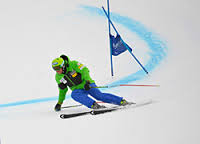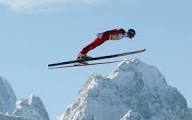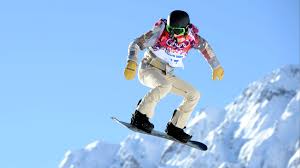Overview
Athletes who ski or snowboard practice for long hours to perfect motions that will earn points in competition, and rely on experts such as coaches and sports scientists to help them win. Sports scientists know that winter sports such as skiing and snowboarding illustrate concepts such as force, gravity, friction, and momentum.
Force, Gravity, and Acceleration: Downhill Skiing
Athletes who practice downhill skiing take advantage of Newton’s Second Law, as expressed in the equation F = ma, where F represents force; m, mass; and a, acceleration. They increase the amount of force by the way that they push down the slope, and gravity accelerates them to speeds over 90 miles an hour. The shape of their skis also affects the amount of friction, as the flat of the ski allows faster glide over the snow, while the edges of the ski create grooves in the snow that allow more control.
Ski Jumping
Ski jumping combines aerodynamics with a combination of forces: drag, lift, and gravity. There are actually four parts to a successful ski jump; the descent down the ramp or inrun, the jump itself, the fly, and the landing. Ski jumpers position their bodies during the inrun with their chests as close to parallel to the snow as possible and their arms behind them. This allows them to gain the maximum speed by minimizing drag. They leap off the ramp with upward force and skis in a V position to catch the most air, in less than a tenth of a second. They glide through the air, using the force of the air on their chests and the surface area of their skis, landing gracefully hundreds of meters away.
Aerial Skiing
Aerial skiing, or freestyle, combines aspects of ski jumping with twists and spins while the skier is in the air. Aerialists propel themselves off steep ramps 50 to 60 feet in the air, pushing off the ramp. They twist and turn with precise arm, leg, torso, and hip movements, creating torque and using their angular momentum. For example, skiers can move one arm or another to control the direction of their spin, or twist their hips to swivel around. Since every action has an equal and opposite reaction according to Newton’s Third Law, the skier will move in the opposite direction to their arm movement.
Snowboarding
Snowboarding combines techniques and equipment all its own with the dynamic use of gravity, speed, and balance. There are many different types of snowboarding surfaces and locations, but one of the most common is the half-pipe. The half-pipe used in snowboarding can be actually dug out of snow and combines curved sides and a flat bottom. Snowboarders in motion constantly change position. They keep their balance against opposing dynamic forces of gravity and friction from the snow. They build up potential energy by pumping their legs until they can release it as kinetic energy while performing intricate tricks and spins.
Interested in physics tutoring services? Learn more about how we are assisting thousands of students each academic year.
SchoolTutoring Academy is the premier educational services company for K-12 and college students. We offer tutoring programs for students in K-12, AP classes, and college. To learn more about how we help parents and students in Bellingham, WA: visit: Tutoring in Bellingham, WA




